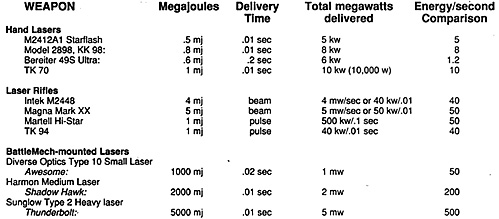Past BattleTechnology articles and departments have described the various models and classifications of laser weapons, ranging from the Starflash laser pistol (Sidearms, Issue 0101) to the mammoth Large Lasers mounted on the Phoenix Hawk and Thunderbolt (as described in BattleMech Weapons, Issue 0201).
Right: Precentor Janos Abu Hassan, the learned author of "BattleMech Weapons: Crisis of Range and Accuracy" in Issue 0201 of BattleTechnology. Precentors are always right.
The subject is an extremely technical one, replete with high-tech jargon and nomenclature; and, inevitably, minor errors are bound to creep into any popular discussion of the field.
Precentor Janos Abu Hassan's article in BattleTechnology, Issue 0201, was a case in point. His article, entitled Battlefidech Weapons: Crisis of Range and Accuracy, contained a minor error overlooked by BattleTechnology's staff at the time.
Precentor Hassan's article described the basic unit by which the power of lasers is measured as the megajoule, which represents one million wafts of energy per second. It went on to discuss the various classes of BattleMech laser weapons: small, medium, and large lasers, each with its own range of destructive potential.
As any MechTech or Warrior knows, of course, most modern BattleMech laser weapons deliver their energy in a single intense, extremely short burst or "pulse" of laser light, often lasting less than one one-hundredth of a second. Thus, a 'Mech's small laser delivers not .8 megajoules of energy, but .8 megawatts, all of it concentrated into that single, intense pulse.
The difference is important when considering other laser weaponry, such as the hand lasers discussed in Issue 0101's Sidearms, andthelaser rifles inthis issue. Atypical laserpistol such as the Optronics M2412A1 "Starflash" has a power output of .5 megajoule; that is, half a megawatt (five hundred kilowatts) of energy is directed against the target over a period of one second. Since the Starflash fires a pulse lasting only one-one hundredth of a second, the actual destructive power directed against the target is only .005 megawatt.
Five kilowatts is a large amount of energy to expend against a small area of a target within a fraction of a second... sufficient to vaporize a small amount of armor or cause hideous damage to unprotected flesh by flash-heating the water contained in cell tissue. However, it is almost insignificant when compared with the output of, say an .8 megawatt small laser mounted by a BattleMech. That weapon delivers eight hundredkilowatts of power in the same space of time as the laser pistol, or 160 times as much energy in the same one one-hundredth of a second. When one looks at these figures and realizes that a small laser is capable of inflicting only a small amount of damage on the armor of a targeted BattleMech, it is easy to see why laser hand weapons are almost useless against'Mechs! The following table is presented to compare the power outputs of the three broad categories of laser weaponry:
Shown on this table are each laser's power output in megajoules (millions of joules per second); the length of time that laser's pulse actually lasts (fractions of a second); the total amount of energy actually delivered to the target by the pulse (in either thousands [k] or millions [m] of watts); and an energy/time compari- son figure. This last allows a direct comparison between the strengths of each type of laser, bycorrecting the power output for the length of a pulse.
The Bereiter laser pistol listed, for example, has a.6 mj output which delivers 6 kilowatts of energy to the target. However, those 6 kilowatts are spread out across a full two-tenths of a second, rather than compressed into a more typical one one-hundredth of a second, resulting in less effectiveness in penetrating armor or damaging a moving target.
The Precentor's article in our last issue of BattleTechnology, then, should refer to megawatt lasers, rather than to megajoules. BattleTechnology Magazine recognizes the fact, however, that ComStar Precentors are incapable of error in any discussion involving science or technology, and therefore accepts full responsibility for the error unwittingly transmitted through the learned Precentor's article in Issue 0201. Any inconvenience to BattleTechnology's readership, or any embarrassment caused the noble Precentor by this error, is deeply regretted.
LASERS COMPARED
| Weapon | Megajoules | Delivery Time | Total Megawatts Delivered | Energy/Second Comparison |
|---|---|---|---|---|
| Hand Lasers | ||||
| M2412A1 Starflash | .5 mj | .01 sec | 5 kw | 5 |
| Model 2898, KK 98 | .8 mj | .01 sec | 8 kw | 8 |
| Bereiter 49S Ultra | .6 mj | .2 sec | 6 kw | 1.2 |
| TK 70 | 1 mj | .01 sec | 10 kw (10,000 w) | 10 |
| Laser Rifles | ||||
| Intek M2448 | 4 mj | beam | 4 mw/sec or 40 kw/.01 | 40 |
| Magna Mark XX | 5 mj | beam | 5 mw/sec or 50 kw/.01 | 50 |
| Martell Hi-Star | 1 mj | pulse | 500 kw/.1 sec | 50 |
| TK 94 | 1 mj | pulse | 40 kw/.01 sec | 40 |
| BattleMech-mounted Lasers | ||||
| Diverse Optics Type 10 Small Laser Awesome | 1000 mj | .02 sec | 1 mw | 50 |
| Harmon Medium Laser Shadow Hawk | 2000 mj | .01 sec | 2 mw | 200 |
| Sunglow Type 2 Heavy Laser Thunderbolt | 5000 mj | .01 sec | 5 mw | 500 |

Back to BattleTechnology 4 Table of Contents
Back to BattleTechnology List of Issues
Back to MagWeb Magazine List
© Copyright 1988 by Pacific Rim Publishing.
This article appears in MagWeb (Magazine Web) on the Internet World Wide Web.
Other military history articles and gaming articles are available at http://www.magweb.com